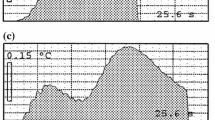Abstract
Venous admixture (Qva/Q) in ARF patients is due to both true right to left shunt (Qs/Qt: perfusion of truly unventilated areas) and to maldistribution ((Qva-Qs)/Qt: effects of unevenness of ventilation/perfusion ratio). Using the retention rate of sulphur hexafluoride we determined the effects of PEEP on Qs/Qt and (Qva-Qs)/Qt at a constant FIO2 for each patient (0.57±0.19 SD, range 0.4–0.95). Eleven patients with ARF (treated either by CPPV or CPAP) were studied on 16 occasions. Each measurement was repeated at two levels of PEEP, 5 cm H2O below and 5 cm H2O above the patient's clinically determined PEEP level. The increase in PEEP resulted in: — a decrease in Qva/Q (from 0.37±0.13 to 0.27±0.12,p<0.01); — a parallel decrease in Qs/Qt (from 0.29±0.16 to 0.22±0.14,p<0.01); there was a positive correlation between Qva/Q and Qs/Qt changes (r=0.53,p<0.05). No significant variation was demonstrated in (Qva-Qs)/Qt (from 0.074±0.045 to 0.054±0.048). On the other hand there was a negative correlation between the fraction of Qva/Q due to the maldistribution and FIO2: (Qva-Qs)/Qva=0.75–0.86 FIO2 (r=0.74,p<0.01). We conclude that: PEEP decreased Qva/Q mainly through changes in Qs/Qt but did not have a definite effect on (Qva-Qs)/Qt. Maldistribution was responsible for a significant portion of Qva/Q in those ARF patients tolerating a relatively low FIO2 (0.4–0.6).
Similar content being viewed by others
References
Cane RD, Shapiro BA, Harrison RA, Steiner MC, Kavanaugh J (1980) Minimizing errors in intrapulmonary shunt calculations. Crit Care Med 8:294
Dantzker DR, Brook JC, Dehart P, Lynch JP, Weg JG (1979) Ventilation-perfusion distributions in the adult respiratory distress syndrome. Am Rev Respir Dis 120:1039
Dantzker DR, Wagner PD, West JB (1975) Instability of lung units with low VA/Q ratios during O2 breathing. J Appl Physiol 38:886
Ellman H, Dembin H (1982) Lack of adverse hemodynamic effects of PEEP in patients with acute respiratory failure. Crit Care Med 10:706
Falke KJ, Pontoppidan H, Kumar A, Leith D, Geffin B, Laver MB (1972) Ventilation with end expiratory pressure in acute lung disease. J Clin Invest 51:2315
Gallagher TJ, Klain MM, Carlon GC (1982) Present status of high frequency ventilation. Crit Care Med 10:613
Gattinoni L, Kolobow T, Tomlinson T, Iapichino G, Samaja M, White D, Pierce J (1978) Low frequency positive pressure ventilation with extracorporeal carbon dioxide removal (LFPPV-ECCO2R): an experimencal study. Anesth Analg 57:470
Lachmann B, Haendley B, Shulz H, Jonson B (1980) Improved arterial oxygenation, CO2 elimination, compliance and decreased barotrauma following changes of volume generated PEEP ventilation with inspiratory/expiratory (I/E) ratio of 1/2 to pressure generated ventilation with I/E ratio of 4/1 in patients with severe adult respiratory distress syndrome (ARDS). Intensive Care Med 6:64
Pesenti A, Latini R, Riboni A, Gattinoni L (1982) Simple estimate of the true right to left shurt (Qs/Qt) at maintenance FIO2 by sulphur hexafluoride retention. Intensive Care Med 8:283
Petty TL (1981) Why (not) try PEEP? Crit Care Med 9:67
Shapiro BA, Cane RD, Harrison RA, Steiner MC (1980) Changes in intrapulmonary shunting with administration of 100% oxygen. Chest 77:138
Shinozaki M, Ueko O, Ueyama H, Muteki T (1981) Measurement of intrapulmonary shunt by SF6 retention rate. I Experimental study on dogs with normal lungs. Jpn J Anesthesiol 30:47
Simonneau G, Lemaire F, Harf A (1981) Evaluation chez l'home des effets hémodynamiques et respiratoires de la ventilation spontanée en pression positive expiratoire (CPAP). Ann Anesth Franç 5:415
Suter PM, Fairley BH, Schlobohm RM (1975) Shunt, lung volume and perfusion during short periods of ventilation with oxygen. Anesthesiology 43:617
Wagner PD, Salzman HA, West JB (1974) Measurement of continuous distribution of ventilation perfusion ratios: theory. J Appl Physiol 36:588
West JB (1977) Ventilation-perfusion relationships. Am Rev Respir. Dis 116:919
Author information
Authors and Affiliations
Additional information
Supported in part by MPI (Rome) grant CAP 18 Art. 1 Ist. 082, FC (1979/80) and CNR (Rome), contract 80.00313.86
Rights and permissions
About this article
Cite this article
Pesenti, A., Riboni, A., Marcolin, R. et al. Venous admixture (Qva/Q) and true shunt (Qs/Qt) in ARF patients: Effects of PEEP at constant FIO2 . Intensive Care Med 9, 307–311 (1983). https://doi.org/10.1007/BF01692548
Accepted:
Issue Date:
DOI: https://doi.org/10.1007/BF01692548




